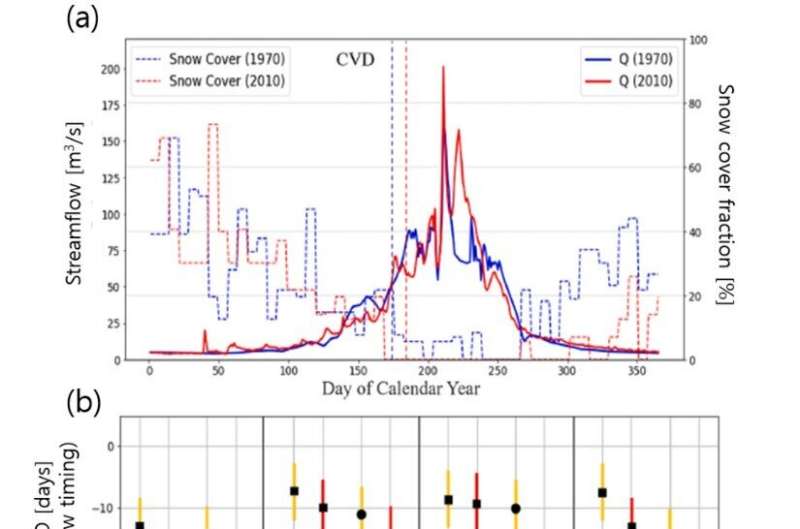This article has been reviewed according to Science X's editorial process and policies. Editors have highlighted the following attributes while ensuring the content's credibility:
fact-checked
proofread
Study: Streamflow timing in Pakistan will become three times faster by end of century

Nature has remained in balance for a long time, but climate change due to modern human activities is disrupting the balance of the natural system. The disruption makes it more difficult for humans—who must work with nature to survive—to predict the future. Moreover, developing countries with limited understanding and preparation for climate change are more vulnerable to climate change-driven social and economic damage.
Recently, a research team from POSTECH corrected the biases of future regional climate model projection data to better understand seasonal changes in the streamflow regime in Pakistan's four main rivers in the mid and late 21st century.
POSTECH'S research team led by Professor Jonghun Kam (Division of Environmental Science and Engineering) and post-graduate researcher Shahid Ali assessed the past and future changes in streamflow timing of the four major river basins of Pakistan including Upper Indus, Kabul, Jhelum, and Chenab River basins. The research team used observational data and bias-corrected hydrological projections. This study was recently published in the Journal of Hydrology.
Hydrology mainly deals with the cycle of water on Earth and the use of surface water. As the science explores the complexity of the natural water flow, various assumptions, statistics, and mathematical techniques, instead of reproduction in the lab, are used to study precipitation, runoff, infiltration, and streamflow and provide basic knowledge and data for the use of water resources. However, climate change and human activities are changing the water cycle itself, rendering it difficult to solve future problems with past knowledge and data.
Pakistan is a representative example of a country suffering severe seasonal changes in streamflow, causing a lack of available water resources for agriculture. To make it worse, the Indus River was inundated over the downstream regions of Pakistan last year, causing catastrophic effects on regional communities. However, understanding of future seasonal changes in streamflow over Pakistan remains limited.
The researchers simulated the VIC-river routing model forced by surface and runoff data from six regional climate models. They later corrected the minimum and seasonality bias against observational records. To quantify seasonal changes in the hydrologic regime, they computed half of the annual cumulative streamflows (HSCs) and the dates of reaching to the first quartile (25th percentile), that is, center-of-volume dates (CVDs) from observed and bias-corrected simulated streamflow data.
Observational records (1962–2019) showed a significant decreasing trend in CVD by a range between -4.5 and -12.6 days across the three river basins, except for Chenab River basin. Bias-corrected hydrologic projections showed decreased CVD by −4.2 to −6.3 days during the observational period. The four study river basins showed that the decreased CVDs range from −5 to −20 days in the near future (the 2050 to 2059 average) and −11 days to −37 days in the far future (the 2090 to 2099 average).
Professor Kam explained, "In late winter, accelerated snow melting processes over mountainous regions in Pakistan can cause changes in available water resources for crop planting in spring. This study highlights diversity in the hydrologic response to a similar magnitude of surface warming in the future climate projection." He added, "there is an urgent need to prepare basin-specific water resources management and policies in order to adapt to climate change."
More information: Shahid Ali et al, Past and future changes toward earlier timing of streamflow over Pakistan from bias-corrected regional climate projections (1962–2099), Journal of Hydrology (2022). DOI: 10.1016/j.jhydrol.2022.128959
Provided by Pohang University of Science & Technology (POSTECH)





















